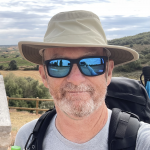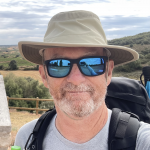One of the biggest challenges to my sense of certainty came when I began to question my belief in God. I had been raised in a religious household, and for years I held fast to the belief that God was a loving and benevolent force in the world. But as I learned more about the world and met people with different beliefs, I began to doubt.
This doubt was terrifying to me at first. It felt like I was losing something essential to my identity. I no longer felt comfortable around very religious family members, coworkers, or friends. Not feeling like I belonged made me more sensitive to ingroup and outgroup dynamics, propaganda, and politics. As I continued to question and explore, I realized that my sense of certainty had actually been holding me back. It was preventing me from truly engaging with the world and seeing it for what it was.
One of the biggest turning points in my journey came when I decided to walk the Camino de Santiago. This ancient pilgrimage route has been a source of inspiration and transformation for countless people over the centuries. For me, it was a chance to step out of my comfort zone and confront the uncertainty brought on by the COVID pandemic, head-on. I had hours and days to walk contemplatively with my thoughts. I met and had meaningful conversations with so many diverse and interesting people from all over the world.
As I walked the Camino, I was struck by the beauty and mystery of Northern Spain. In every city and village, there were ancient churches with symbols, some esoteric, others embued with new modern meanings. I saw things that challenged my assumptions and challenged my beliefs, and I was forced to confront my limitations. I realized that I didn't have all the answers and that the world was far more complex and wondrous than I had ever imagined.
There was a moment on the Camino just out of Belorado when I truly believed that I would not be able to make it all the way to Santiago. I had 4 open blisters, arthritis acting up in my hips, and my ankle was swollen up like softball. I wrote at length about dealing with my mind junk on the Camino in a separate blog post about overthinking.
This Camino experience helped me understand what Carl Jung was trying to express when he said, "I began calling God all those things which cross my willful path violently and recklessly, all things which upset my subjective views, plans, and intentions, and change the course of my life for better or for worse." To Jung, the divine was a force that disrupted everything - a great mystery that was at work in the world.
For me, the Camino was a revelation. Maybe it helped me develop a more personal understanding of my belief in God, a version that I now consider some kind of Fate, similar to Jung's concept of the divine. Maybe that is why the Stoics embrace Amor Fati. Love your fate. Can we ever truly know?
The Camino showed me that my belief in God wasn't a matter of certainty, but of faith. It was a choice to trust in something greater than myself, even in the face of uncertainty. And as Pascal's Wager reminds us, it is better to believe in God and be wrong, than to not believe and be wrong.
Lately, it has been comforting to just call God by the name of my choosing, Fate, as Steven Pressfield alluded to in "Put Your Ass Where Your Heart Is." So, in addition to Pascal's Wager, I have chosen to believe, like Pressfield, that the higher and lower dimensions interact and communicate. Let me tell you why.
One misty morning on the Camino, Cristina and I were climbing a massive hill out of Castrojeriz, and I felt a powerful presence accompanying me. I didn't know for sure who or what it was. At the top of that great hill, I came upon a thoughtful shrine built as a memorial for a Spanish guy named Manuel Picasso Lopez. It had a beautiful inscription. I took a picture to remember the kind words inscribed about how much he was loved. The shrine was adorned with all kinds of pictures of other people's loved ones, burden stones, prayer cards, and all kinds of symbolic items we can never know the true significance of. I remember thinking that "this" represents the hope, faith, and grief of thousands of pilgrims who had passed by before me. I placed a stone on it for a friend's son who had committed suicide a few years earlier. I said a prayer asking for her to be comforted. And I cried with all of them, as I walked for the next few kilometers. This magical experience was moving me so, and I did not understand why.
Later that day Fate visited me again in Frómista when my sister called to tell me that my father had passed away. I was not surprised. I recognized that he had been the one climbing with me on that massive hill out of Castrojeriz. With much reflection, I don't know this, but I choose to believe it. I believe it was he who accompanied me all that way, and for several hours later. I later learned that I had that mysterious and inexplicable "visitation" experience at the exact time of his death, even though we were separated halfway around the world. None of these are things I know, or can they even be known, in my view. But they can be believed.
In the end, my journey on the Camino has helped me to deal in kind with certainty and uncertainty by presenting me with and allowing me to embrace more of the mysteries of this world. It taught me that there is always more to learn and discover and that our beliefs and principles ought be open to revision. It's a journey. Journeys are about movement. And most importantly, it showed me the power of faith and trust in the face of the grief.
Others have walked this uncertain path called life meaningfully and successfully. I think that shrine, just over the top of that massive hill outside of Castrojeriz, dedicated to the life-path of Manuel Picasso Lopez, represents a life well-walked. Like Manuel, surely, we can also walk "this Way."
I was fortunate to be able to walk a long, long ways on the Camino with my father from just outside of Castrojeriz to Santiago and beyond. Well, that is what I believe. I'm not certain. And it doesn't matter.
¡Viva la Meseta!



